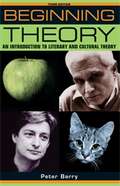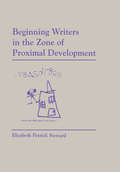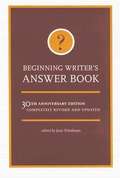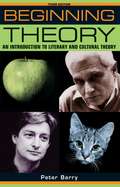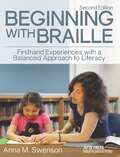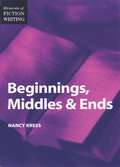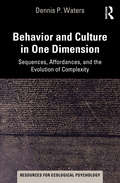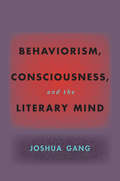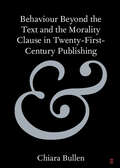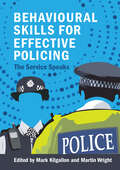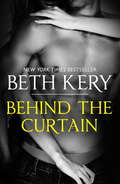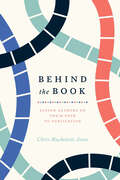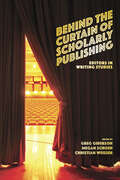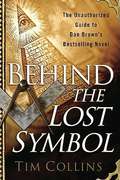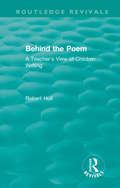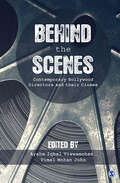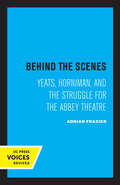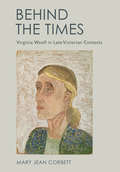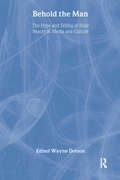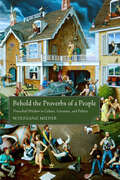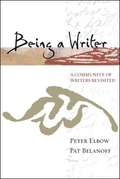- Table View
- List View
Beginning Theory: An Introduction to Literary and Cultural Theory (Third Edition)
by Peter BarryBeginning theory has been helping students navigate through the thickets of literary and cultural theory for well over a decade now. This new and expanded third edition continues to offer students and readers the best one-volume introduction to the field. The bewildering variety of approaches, theorists and technical language is lucidly and expertly unravelled. Unlike many books which assume certain positions about the critics and the theories they represent, Peter Barry allows readers to develop their own ideas once first principles and concepts have been grasped. The book has been updated and includes two new chapters, one of which (Literary theory - a history in ten events) innovatively surveys the course of theory, while the other (Theory after 'Theory') maps the arrival of new 'isms' since the second edition appeared in 2002. Liberal humanism - Structuralism - Post-structuralism and deconstruction - Postmodernism - Psychoanalytic criticism - Feminist criticism - Lesbian/gay criticism - Marxist criticism - New historicism and cultural materialism - Postcolonial criticism - Stylistics - Narratology - Ecocriticism - Presentism/Transversal poetics/ New aestheticism/Historical formalism/Cognitive poetics.
Beginning Writers in the Zone of Proximal Development
by Elizabeth Petrick-StewardHow do young children bridge the gap between "writing" a story with pictures and writing with words? How children learn to use written words to tell a story is a topic important to both cognitive development and early literacy instruction. Using the theoretical framework developed by Vygotsky, the behavior of a group of prekindergarten children as they author two consecutive pieces of writing is analyzed. The children tell their stories at first with spoken words and pictures. As they discuss their work-in-progress in public conferences, they discover how to build on and combine existing skills to produce a new skill -- telling stories with written words. Current descriptive and theoretical perspectives on beginning writing are presented in this volume, with a particular focus on Vygotsky's concept of the zone of proximal development, a period of sensitivity in which learning advances. The proposed mechanism of change is verbal mediation -- talk among peers and teachers as they discuss work-in-progress -- which moves the children through the zone of proximal development. An open, whole-language approach to literacy instruction makes the classroom in this book an ideal arena in which to observe verbal mediation in operation. Children are free to question, criticize and argue; and in the process they collectively advance their developing ability to use written language. The work is unique in that the rich and comprehensive data record is reproduced in its entirety. More than 400 illustrations of the children's products -- two "books" apiece, pictured before and after the children's revisions -- are included, along with transcripts of the conferences about each of the pages, permitting direct observation of the effects of verbal mediation. This dynamic study documents change during a period of time when specific learning is occurring, and provides strong support for the value and power of Vygotsky's theoretical framework.
Beginning Writers' Answer Book (30th anniversary ed.)
by Jane FriedmanIn a question and answer format, this book provides information for writers in all genres about how to submit work, find an agent, and cooperate with a publisher.
Beginning theory [An introduction to literary and cultural theory]: An Introduction To Literary And Cultural Theory (Beginnings Ser.)
by Peter BarrySince the first edition of this book (which was written in the earlier part of the 1990s) literary theory has continued to change and develop. To reflect these developments, I have added a new chapter on ecocriticism, making this the first book of its kind to register the increasing interest in 'Green' approaches to literature. Of course, my own feelings about the various kinds of theory have changed a bit too. In particular, I now find structuralism rather more interesting than poststructuralism, and to reflect this I have added a new chapter on narratology, a branch of structuralist theory which lends itself very readily to enjoyable and thought-provoking practical applications. Apart from these new chapters, the second edition is the same book as the first, but with up-dated bibliographies.
Beginning with Braille
by Anna M. SwensonWritten by a gifted practitioner, Beginning with Braille offers teachers a variety of practical strategies for designing and delivering braille instruction. This guide emphasizes the balance between a meaning-centered approach and braille reading skills for early literacy and beginning readers and writers, as well as children with multiple disabilities. It provides suggestions for reading aloud to young children, selecting and making early tactile books, and teaching tactile and hand movement skills, as well as tips on the braille writing process. Reading Beginning with Braille, with its numerous suggestions and examples, is like having a mentor by your side.
Beginnings, Middles and Ends
by Nancy KressGet your stories off to a roaring start. Keep them tight and crisp throughout. Conclude them with a wallop. Is the story or novel you've been carrying around in your head the same one you see on the page? Or does the dialogue suddenly sound flat and predictable? Do the events seem to ramble? Translating a flash of inspiration into a compelling story requires careful crafting. The words you choose, how you describe characters, and the way you orchestrate conflict all make the difference - the difference between a story that is slow to begin, flounders midway, or trails off at the end - and one that holds the interest of readers and editors to the final page. By demonstrating effective solutions for potential problems at each stage of your story, Nancy Kress will help you. . . hook the editor on the first three paragraphs make - and keep - your story's "implicit promise" build drama and credibility by controlling your prose Dozens of exercises help you strengthen your short story or novel. Plus, you'll sharpen skills and gain new insight into. . . the price a writer pays for flashbacks six ways characters should "reveal" themselves techniques for writing - and rewriting Let this working resource be your guide to successful stories - from beginning to end.
Beginnings: Intention and Method
by Edward W. SaidThis reissued classic traces the ramifications and diverse understandings of the concept of "Beginning" in history and offers valuable insights into the role of the intellectual and the goal of criticism.
Behavior and Culture in One Dimension: Sequences, Affordances, and the Evolution of Complexity (Resources for Ecological Psychology Series)
by Dennis P. WatersBehavior and Culture in One Dimension adopts a broad interdisciplinary approach, presenting a unified theory of sequences and their functions and an overview of how they underpin the evolution of complexity. Sequences of DNA guide the functioning of the living world, sequences of speech and writing choreograph the intricacies of human culture, and sequences of code oversee the operation of our literate technological civilization. These linear patterns function under their own rules, which have never been fully explored. It is time for them to get their due. This book explores the one-dimensional sequences that orchestrate the structure and behavior of our three-dimensional habitat. Using Gibsonian concepts of perception, action, and affordances, as well as the works of Howard Pattee, the book examines the role of sequences in the human behavioral and cultural world of speech, writing, and mathematics. The book offers a Darwinian framework for understanding human cultural evolution and locates the two major informational transitions in the origins of life and civilization. It will be of interest to students and researchers in ecological psychology, linguistics, cognitive science, and the social and biological sciences.
Behavior and Culture in One Dimension: Sequences, Affordances, and the Evolution of Complexity (Resources for Ecological Psychology Series)
by Dennis WatersBehavior and Culture in One Dimension adopts a broad interdisciplinary approach, presenting a unified theory of sequences and their functions and an overview of how they underpin the evolution of complexity.Sequences of DNA guide the functioning of the living world, sequences of speech and writing choreograph the intricacies of human culture, and sequences of code oversee the operation of our literate technological civilization. These linear patterns function under their own rules, which have never been fully explored. It is time for them to get their due. This book explores the one-dimensional sequences that orchestrate the structure and behavior of our three-dimensional habitat. Using Gibsonian concepts of perception, action, and affordances, as well as the works of Howard Pattee, the book examines the role of sequences in the human behavioral and cultural world of speech, writing, and mathematics. The book offers a Darwinian framework for understanding human cultural evolution and locates the two major informational transitions in the origins of life and civilization. It will be of interest to students and researchers in ecological psychology, linguistics, cognitive science, and the social and biological sciences.
Behaviorism, Consciousness, and the Literary Mind (Hopkins Studies in Modernism)
by Joshua GangWhat might behaviorism, that debunked school of psychology, tell us about literature?If inanimate objects such as novels or poems have no mental properties of their own, then why do we talk about them as if they do? Why do we perceive the minds of characters, narrators, and speakers as if they were comparable to our own? In Behaviorism, Consciousness, and the Literary Mind, Joshua Gang offers a radical new approach to these questions, which are among the most challenging philosophical problems faced by literary study today.Recent cognitive criticism has tried to answer these questions by looking for similarities and analogies between literary form and the processes of the brain. In contrast, Gang turns to one of the twentieth century's most infamous psychological doctrines: behaviorism. Beginning in 1913, a range of psychologists and philosophers—including John B. Watson, B. F. Skinner, and Gilbert Ryle—argued that many of the things we talk about as mental phenomena aren't at all interior but rather misunderstood behaviors and physiological processes. Today, behaviorism has relatively little scientific value, but Gang argues for its enormous critical value for thinking about why language is so good at creating illusions of mental life.Turning to behaviorism's own literary history, Gang offers the first sustained examination of the outmoded science's place in twentieth-century literature and criticism. Through innovative readings of figures such as I. A. Richards, the American New Critics, Samuel Beckett, Harold Pinter, and J. M. Coetzee, Behaviorism, Consciousness, and the Literary Mind reveals important convergences between modernist writers, experimental psychology, and analytic philosophy of mind—while also giving readers a new framework for thinking about some of literature's most fundamental and exciting questions.
Behaviour Beyond the Text and the Morality Clause in Twenty-First-Century Publishing (Elements in Publishing and Book Culture)
by Chiara BullenA morality clause allows contracting parties to terminate a contractual agreement with those who exhibit behaviour deemed unacceptable. Established in 1920s Hollywood, these contractual clauses are now found in twenty-first-century publishing agreements. This Element investigates the presence of the morality clause in the UK book publishing industry in relation to an increased focus on author behaviour beyond the text in the twenty-first-century, examining the way it operates within the publishing field in the context of behaviour perceived to be 'problematic'. It asserts the clause is perceived to be needed due to the emergence of social media and twenty-first-century social contexts combining to impact the author-reader relationship which, in turn, leads to author behaviour acting as a paratextual threshold to their work. This Element presents an analysis of the morality clause in practice, concluding the clause has the potential to further the power imbalance between author and publisher.
Behavioural Skills for Effective Policing: The Service Speaks
by Martin Wright Mark KilgallonBehavioural skills are essential to effective policing practice and professional development, and are also embedded within the policing competency frameworks. As the police service looks to further redefine its role in the twenty-first century, this critical handbook covers the full range of these proficiencies, from building rapport, applying emotional intelligence, building empathy and resilience to diversity and difference, understanding ethics, and developing coaching and leadership skills.Each chapter is written by a distinguished serving or former senior police leader and/or policing scholar, bringing together a wealth of experience and understanding and applying this knowledge in context through key case studies and examples. Suitable for serving police officers at all levels, as well as policing lecturers and students aspiring to join the police, this book encourages and enables a people-centred approach to policing that balances the debate that has given disproportionate credence to transactional skills at the expense of a more transformational approach.
Behind Kṛṣṇa’s Smile: The Lord’s Hint of Laughter in the Bhagavadgītā and Beyond (SUNY series in Hindu Studies)
by Antonio Rigopoulos Gianni PellegriniBehind Kṛṣṇa's Smile offers a wholly original perspective on the celebrated Bhagavadgītā, or "Song of God." The book investigates Kṛṣṇa's hint of laughter (prahasann iva) in Bhagavadgītā 2.10, which is generally understood to be the turning point of the famous poem, signaling the outpouring of his grace and teaching to Arjuna. Remarkably, it is from this verse that Śaṅkara and other leading theologians begin to write their commentaries. In addition to exploring the momentousness of Kṛṣṇa's hint of laughter and its impact on the poem's central teachings, Behind Kṛṣṇa's Smile provides a crucial interpretation of Kṛṣṇa's prahasann iva in the Vedānta commentarial tradition, from Śaṅkara up to modern times. The book also considers the meanings of the stock phrase prahasann iva in the larger epic framework of the Mahābhārata and Rāmāyaṇa. Moreover, the book offers the first comprehensive review of the significance of Kṛṣṇa's smile in Kṛṣṇaite iconography and literature, demonstrating that there is a unified canon bringing together the literary and performative dimensions of Kṛṣṇa’s hint of laughter.
Behind The Curtain
by Beth KeryFrom the New York Times bestselling author of Because You Are Mine, The Affair and Make Me - Behind the Curtain is a seductive standalone romance, perfect for fans of E. L. James, Sylvia Day, Jodi Ellen Malpas and J. Kenner, that will have you begging for more...There's something about this woman that could bring a man to his knees...On a break between overseas jobs, journalist Asher Gaites returns to his hometown of Chicago - and allows his friends to persuade him to check out a hot new singer. At a downtown jazz club, he's soon transfixed by the lyrical voice and sensuous body of a woman who performs behind a thin, shimmering veil...The veil gives Moroccan-American Laila Barek the anonymity she needs, since she has never been able to reconcile her family's values with her passion for music. But one man is inexplicably drawn to her. And when Asher confronts her on a subway platform after a gig, he's shocked to recognize the woman who walked away from him eight years ago...Laila has never been able to forget the touch, the feel, the taste of Asher. And despite the doubt and fear that wind their way into their lives, they must trust the heat of their desire to burn down the walls the world has placed between them...Discover the other captivating titles by Beth Kery: Looking Inside, Make Me, The Affair, the One Night of Passion series, and her bestselling erotically charged series which began with Because You Are Mine.
Behind the Book: Eleven Authors on Their Path to Publication (Chicago Guides to Writing, Editing, and Publishing)
by Chris Mackenzie JonesEvery book has a story of its own, a path leading from the initial idea that sparked it to its emergence into the world in published form. No two books follow quite the same path, but all are shaped by a similar array of market forces and writing craft concerns as well as by a cast of characters stretching beyond the author. Behind the Book explores how eleven contemporary first-time authors, in genres ranging from post-apocalyptic fiction to young adult fantasy to travel memoir, navigated these pathways with their debut works. Based on extensive interviews with the authors, it covers the process of writing and publishing a book from beginning to end, including idea generation, developing a process, building a support network, revising the manuscript, finding the right approach to publication, building awareness, and ultimately moving on to the next project. It also includes insights from editors, agents, publishers, and others who helped to bring these projects to life. Unlike other books on writing craft, Behind the Book looks at the larger picture of how an author’s work and choices can affect the outcome of a project. The authors profiled in each story open up about their challenges, mistakes, and successes. While their paths to publication may be unique, together they offer important lessons that authors of all types can apply to their own writing journeys.
Behind the Curtain of Scholarly Publishing: Editors in Writing Studies
by Greg Giberson Megan Schoen Christian WeisserUntil now there has been little consideration of the intellectual and historical impact editors have had on the young and ever-evolving field of writing studies. Behind the Curtain of Scholarly Publishing provides new and seasoned scholars with behind-the-scenes explorations and expositions of the history of scholarly editing and the role of the scholarly editor from the perspectives of current and former editors from important publications within the field. Each chapter in the collection examines the unique experiences and individual contributions of its authors during their time as editors, offering advice to scholars and potential editors on how to navigate the publication process and understand editorial roles. The contributors provide multiple perspectives on the growth, transformation, and, in some cases, founding of some of the most influential publishing venues in writing studies. The personal and historical narratives, along with the unique perspectives and insightful analyses of the individual authors in Behind the Curtain of Scholarly Publishing, offer needed transparency and context to what has historically been an opaque, yet inevitable and consequential, part of academic life. This volume will help researchers in the field understand the publishing process. Contributors: Cheryl Ball, David Bartholomae, Charles Bazerman, Jean Ferguson Carr, Douglas Eyman, Muriel Harris, Byron Hawk, Alice Horning, Paul Kei Matsuda, Laura Micciche, Mike Palmquist, Michael Pemberton, Malea Powell, Kelly Ritter, Victor Villanueva, Victor Vitanza, Kathleen Blake Yancey
Behind the Lost Symbol: The Unauthorized Guide to Dan Brown's Bestselling Novel
by Tim CollinsTHE SYMBOL WAS LOST... BUT THE TRUTH HAS BEEN FOUND!<P> With his blockbuster bestselling novels The Da Vinci Code and Angels and Demons, author Dan Brown introduced readers to a world of symbols and secret societies, men of God warring with men of Science, and the adventures of brilliant Harvard symbologist Robert Langdon. Now, with his newest novel, The Lost Symbol, Brown has woven a complex web of intrigue, religion, technology, and great historical figures guiding the destiny of mankind.<P> Inside this book, you will find the truth behind The Lost Symbol's history and myths, such as:<P> * The strength and influence of the enigmatic Freemasons throughout history <P> * The founding fathers of the United States--and their possible connections with secret organizations such as the Illuminati and the Templars <P> * The meaning within the symbols of the Great Seal of the United States <P> * The identity of the Masonic "Great Architect of the Universe" <P> * And so much more! <P> For armchair historians and devoted fans-or those who want to know where the line is drawn between fact and fiction-this is the ultimate guide to the mysteries, symbolism, and historical contexts of Dan Brown's thrilling novel.
Behind the Poem: A Teacher's View of Children Writing (Routledge Revivals)
by Robert HullPublished in 1988, this book is a teacher’s eye view of how children come to write and rewrite poems, and of how they make aesthetic choices in their writing. Drawing on over twenty years’ experience of teaching poetry in primary and secondary schools, Robert Hull presents a detailed account of the process of writing poetry in the classroom. The reader is invited, almost in confidence, to be witness to a skilled teacher’s planning, recognition, and definition of children’s emergent understanding and expertise. The author adopts a non-behaviourist model which stresses difficulty and uncertainty, rejecting a simplistic assumption of linear progression, predictability of outcome, and short-term results. The many examples of poems written by the children demonstrate in a very vivid and impressive way the value of this approach. All teachers, not just of poetry, will find this a fascinating and informed study, and an inspiration for their own work in the classroom.
Behind the Scenes: Contemporary Bollywood Directors and Their Cinema
by Aysha Iqbal Viswamohan and Vimal Mohan JohnFor those who think, read, teach, and write about Bollywood, this book is the release of the year! They are the ‘stars’ who sit behind the camera and create magic between ‘Action’ and ‘Cut’. Meet the directors of New Age cinema who with their themes, characteristic styles, and masterful storytelling are bridging the gap between commerce and content, commercial and art-house cinema. This book introduces you to the films they have made and provides a critical analysis of their craft, while remaining grounded in cinematic and popular culture theories. It shows the distinct ways in which they have handled issues of gender, urban culture, and social inequality.
Behind the Scenes: Yeats, Horniman, and the Struggle for the Abbey Theatre (The New Historicism: Studies in Cultural Poetics #11)
by Adrian FrazierBehind the Scenes presents the story of Dublin's famous Abbey Theatre and its major creative personalities: W. B. Yeats, Annie Horniman, J. M. Synge, and Lady Gregory. Part history, part sociology, part biography, Frazier's work recreates the forces that shaped the Abbey stage, forces that involved the spirited participation of actors, audiences, press, and financiers as well as of the famous poet-playwright who was its co-director. His book unfolds an entertaining and suspenseful tale, centered on the undeniably autocratic personality of W.B. Yeats and with the political struggles of Ireland as a backdrop. This title is part of UC Press's Voices Revived program, which commemorates University of California Press's mission to seek out and cultivate the brightest minds and give them voice, reach, and impact. Drawing on a backlist dating to 1893, Voices Revived makes high-quality, peer-reviewed scholarship accessible once again using print-on-demand technology. This title was originally published in 1990.
Behind the Stories: Christian Novelists Reveal the Heart in the Art of Their Writing
by Diane EbleAs editor of the "PageTurner's Journal," Diane Eble has interviewed all the top fiction authors in the Christian market. Now, in "Behind the Stories," she shares inspiring personal conversations with each author. This memoir includes photos and never-before-published thoughts and interests of many of the best Christian novelists of today.
Behind the Times: Virginia Woolf in Late-Victorian Contexts
by Mary Jean CorbettVirginia Woolf, throughout her career as a novelist and critic, deliberately framed herself as a modern writer invested in literary tradition but not bound to its conventions; engaged with politics but not a propagandist; a woman of letters but not a "lady novelist." As a result, Woolf ignored or disparaged most of the women writers of her parents' generation, leading feminist critics to position her primarily as a forward-thinking modernist who rejected a stultifying Victorian past. In Behind the Times, Mary Jean Corbett finds that Woolf did not dismiss this history as much as she boldly rewrote it.Exploring the connections between Woolf's immediate and extended family and the broader contexts of late-Victorian literary and political culture, Corbett emphasizes the ongoing significance of the previous generation's concerns and controversies to Woolf's considerable achievements. Behind the Times rereads and revises Woolf's creative works, politics, and criticism in relation to women writers including the New Woman novelist Sarah Grand, the novelist and playwright, Lucy Clifford; the novelist and anti-suffragist, Mary Augusta Ward. It explores Woolf's attitudes to late-Victorian women's philanthropy, the social purity movement, and women's suffrage. Closely tracking the ways in which Woolf both followed and departed from these predecessors, Corbett complicates Woolf's identity as a modernist, her navigation of the literary marketplace, her ambivalence about literary professionalism and the mixing of art and politics, and the emergence of feminism as a persistent concern of her work.
Behold the Man: The Hype and Selling of Male Beauty in Media and Culture
by Edisol DotsonThe first comprehensive study of how images of male beauty are projected onto society, Behold the Man: The Hype and Selling of Male Beauty in Media and Culture examines the role media and society play in creating the image of the idealized male. This book explores how these images are interpreted by all genders and sexual orientations in order to investigate the phenomenon’s effect on the self-esteem of adolescent and adult males. Behold the Man provides you with research and examples that identify this problem from many angles to help you realize that being a man is more than merely possessing muscles and good looks.Discussing examples in which both attractive men and women are idealized as “the norm,” Behold the Man argues that men are experiencing the same injustices as women--splashed on the covers of magazines and in advertisements, based on their sex appeal, sometimes to promote nothing more than their looks. Within Behold the Man, you‘ll find topics that relate to the reasons for and effects of male beauty standards, such as: aspects of male beauty, from Ancient Greek ideals to how it is visualized throughout history in art the vision of “the ideal male,” along with sexual connotations, in advertisements for clothing, cologne, sunglasses, automobiles, and shaving products the emphasis of strong, well-built males and their bodies in movies, music videos, and literature how men alter their bodies by dieting and cosmetic surgery to achieve the look found in advertisements today’s growing numbers of male eating disorders caused by the notion that only good-looking, muscular men are acceptable reasons behind the exploitation of the male body and the double standards for male beauty found within gay male communities how advertisers and authors faithfully follow the “bigger is better” theory--from pectoral and bicep muscles to penis sizeRecognizing how society has created and changed the appearance of the ideal male, this text explains to you the danger men of all ages face who feel they need to be physically handsome to be desirable. From Behold the Man, you’ll learn about the real messages of advertising and media, the problems they cause, and that true self-worth cannot be measured by physical attributes.
Behold the Proverbs of a People: Proverbial Wisdom in Culture, Literature, and Politics
by Wolfgang MiederThe thirteen chapters of this book comprise an intriguing and informative entry into the world of proverb scholarship, illustrating that proverbs have always been and continue to be wisdom's international currency. The first section of the book focuses on the field of paremiology (proverb studies) in general, the spread of Anglo-American proverbs in Europe, and the phenomenon of modern proverbs. The second section analyzes the use of proverbs in the world of politics, including a chapter on President Obama, while the third concentrates on the uses of proverbs in literature. The final section ends with detailed cultural studies of the origin, history, dissemination, use, function, and meaning of specific proverbs.Noted scholar Wolfgang Mieder shows that proverbs matter in culture, literature, and politics. Proverbs remain part and parcel of oral and written communication, and, he demonstrates, they deserve to be studied from a range of viewpoints. While various chapters deal with a variety of issues and approaches, they cohere through a rhetorical perspective that looks at the text, texture, and context of proverbs as speech acts that make a noteworthy impact on culture and society. Whether proverbs appear in everyday speech, on the radio, on television, in films, on the pages of newspapers or magazines, in advertisements, in literary works, or in political speeches, they serve as formulaic verbal devices to add authoritative weight through tradition, convention, and wisdom.
Being A Writer: A Community of Writers Revisited
by Peter Elbow Patricia BelanoffBeing A Writer is a brief rhetoric that explores writing processes with an emphasis on their variety; invention, with an emphasis on its playfulness; revision as a technique of invention; collaboration as a means of revision; and personal engagement in academic writing, from literary analysis to argument.
